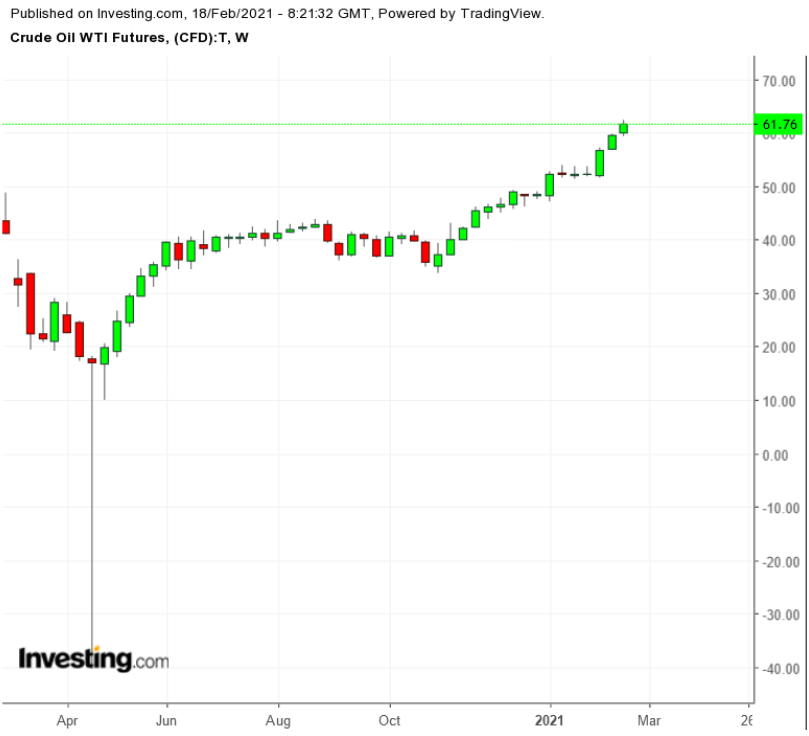It's coming up on a year since the coronavirus pandemic exploded across the world and global lockdowns expanded beyond China to almost all of the rest of the world. The global oil demand situation remains uncertain.
However, some aspects of the oil market are now better understood. Currently, it's crucial to break down what the winter freeze is doing to Texas-area oil production and refining; what OPEC+ is likely to do when it meets in two weeks; why U.S. fuel prices are up; and what, if anything, we can glean right now about the future of oil demand:
1. Temporary Disruptions in U.S. Oil Supply
Frigid temperatures in Texas have caused a significant drop in crude oil production in the United States this week. According to the latest information, more than 4 million bpd of oil (out of the 4.6 million bpd Texas typically produces) is now offline. That represents about 40% of total U.S. oil production.
For comparison, this past October, producers shut about 92% of crude oil production in the Gulf of Mexico in preparation for Hurricane Delta, which amounted to 1.68 million bpd. Temperatures are supposed to improve through the weekend. The disruption may last until next week, but some production could be offline longer if significant repairs are needed.
Most of the refining capacity in the Gulf of Mexico region is also offline for similar reasons. The refining disruption likely amounts to about 4 million bpd. Oil prices rose at the beginning of the week on news that such shutdowns might be coming, and WTI finally topped the $60 per barrel mark.

Prices rose another 1% on Wednesday, as more details about the disruptions became clear, though traders should be prepared for some retreat from these price gains as production and refining return. Gasoline prices are also rising in the United States as a result of the refinery outages. For example, prices increased about $0.05 per gallon in the Midwest on Wednesday.
These outages won’t be evident in the Feb. 18 weekly EIA report on U.S. oil production and consumption, but traders should expect to see these outages reflected in the data released next week and beyond.
2. OPEC+ to Meet on March 4
OPEC+ members are preparing to meet in two weeks and have already started presenting their positions to the media. Currently, Saudi Arabia is holding back an extra 1 million bpd of production, but, according to reporting from the Wall Street Journal, it intends to continue this policy only through the end of March.
Saudi Arabia will resume pumping at its quota in April. This was Saudi Arabia’s position when it announced the “surprise cuts” back in January, so this information confirms that Saudi Arabia’s policy hasn’t changed in the last few weeks.
Russia, on the other hand, was authorized by OPEC+ to increase production in February and March, but it hasn’t been able to pump more barrels due to abnormally cold weather. Russia’s production has actually averaged 10.115 million bpd in February, about 44,000 bpd less than January. It is possible that warmer temperatures in March may bring an increase in Russia’s oil production.
When it meets on Mar. 4, OPEC+ will decide whether to continue pumping at current levels in April (with an additional 1 million bpd from Saudi Arabia returning) or it could decide to increase production rates since prices are higher. Russia indicated this week that it believes the oil market is balanced, while Saudi Arabia expressed more cautious and tempered optimism about the current state of the market.
3. Higher Fuel Prices in the U.S.
The average price of a gallon of gasoline has increased nearly $0.20 in the past month, sparking concerns that U.S. consumers may see a return to the high gasoline prices that characterized the Obama administration. Some of the increase in oil prices, and therefore gasoline prices, can be tied to the sentiment created by the Biden administration’s early executive orders on oil and gas leasing and oil transportation.
However, these executive orders are not yet impacting the fundamentals. Rising prices are largely due to tightening fundamentals unconnected to these policies.
4. Oil Demand Questionable
Short-term oil demand in the U.S. and Europe is still a major question. Gasoline consumption cannot be expected to return to previous levels until free movement is allowed, children return to school and many more workers return to their offices.
Many European countries have extended their lockdown orders through March or April, though in some countries legislative bodies or courts are overruling the executive’s authority. In the United States, the situation is also unclear. Many school districts in the U.S. have not resumed full-time, in-school classes, so many parents are unable to return to work out of the home. Many forecasters seem to be counting on a resumption of full-time schooling in the autumn, but the political situation in America may make that impossible.
In the long-term, oil demand is expected to grow outside of Europe and Asia. (Last week, this column examined India’s potential growth). Traders should not forget that even if the short-term demand situation is questionable, the long-term demand situation is more certain.
